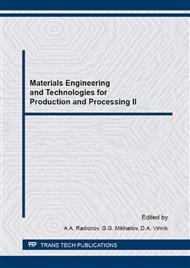[1]
Information on http: /www. uncm. ru/files/uploaded/Pressa_o_nas/Composite_World_AVIA_ 2011. pdf.
Google Scholar
[2]
Information on http: /www. aviaport. ru/news/2013/08/29/262814. html.
Google Scholar
[3]
Y.S. Archangelskiy, Handbook of Microwave electrothermics, Science Book, Saratov, (2011).
Google Scholar
[4]
Y.S. Archangelskiy, Microwave electrotechnology, Saratov School of Technology, Bulletin of Saratov State Technical University. 4 (2011) 5-15.
Google Scholar
[5]
Y.S. Arkhangelskiy, K.N. Ogurcov, E.M. Grishina, The beam type cameras of microwave electrical installations, Volga Printing, Saratov, (2010).
Google Scholar
[6]
V.A. Kolomeytsev, K.V. Shakin, A.N. Zhuravlev, Approximation features of the boundary basic elements conditions of the waveguide resonator microwave devices with non-linear profile over the cross section, in: Proceeding of Electrical and thermal engineering processes and facilities: Interuniversity Sci. Coll. Saratov. (2003).
Google Scholar
[7]
V.V. Komarov, The wording of mathematical models of processes of interaction of electromagnetic waves with dissipative media in microwave heating systems, Physics of wave processes and radio systems. 4 (2010).
Google Scholar
[8]
D.A. Loic, Research and development of microwave materials heat treatment devices in the traveling wave mode, Ph.D. diss., State Institute of Electronics and of mathematics, Moscow, (2009).
Google Scholar
[9]
G.A. Morozov, L.I. Ponomarev, S.V. Rodin, Modeling of microwave heating of layered dielectric environments, Radio-electronic devices and systems: Interuniversity Coll., Kazan. (1996) 117-123.
Google Scholar
[10]
E. Okress, Microwave power, third ed., Moscow, (1971).
Google Scholar
[11]
A.E.S. Clarke, A. Nesbitt, R.J. Day, G.L.A. Sims, Microwave techniques for the preparation of polymer foams, in: Proceedings of the Fourth World Congress on Microwave and Radio Frequency Applications. (2004) 45.
Google Scholar
[12]
J. Clemens, C. Saltiel, Numerical modeling of materials processing in microwave furnaces, Int. J. Heat Mass Transfer. 39 (1996) 1665-1675.
DOI: 10.1016/0017-9310(95)00255-3
Google Scholar
[13]
G. Swaminathan, A.B. Datta, L.N. Satapathy, Microwave sintering of abrasion resistant alumina liner tiles, in: Proceedings of the Fourth World Congress on Microwave and Radio Frequency Applications. (2004) 5.
Google Scholar
[14]
O. Alothman, R.J. Day, A novel microwave-assisted injection moulding of polymers, in: Proceedings of the Fourth World Congress on Microwave and Radio Frequency Applications. (2004) 40.
Google Scholar
[15]
N.V. Bekrenev , I.V. Zlobina, V.A. Kolomeytsev, Features of influence of microwave radiation on organic materials and their compositions during heat treatment, Bulletin Sarat. Gos. Tech. Univ. 4 (2014) 117-121.
Google Scholar
[16]
I.V. Zlobina, V.A. Kolomeytsev, N.V. Bekrenev, Improvement of uniformity of heat treatment by microwave processing of organic materials compositions with microwave radiation, Scientific Review. 12 (2014) 80-83.
Google Scholar
[17]
I.V. Zlobina, V.A. Kolomeytsev, Usage of microwave radiation for the heat treatment of organic dielectric materials with heterogeneous structure and composition, in: Proceeding of Materials of the 11th Intern, Scientific and engineering, Conf. Actual problems of electronic instrument APEP 2014. (2014).
DOI: 10.1109/apede.2014.6958250
Google Scholar
[18]
I.V. Zlobina, N.V. Bekrenev, The application of fractal analysis to quantify the influence of the microwave dielectric heating of organic material compositions on the parameters of their structure, Electrical technologies. 2 (2015) 50-54.
Google Scholar
[19]
I.V. Zlobina, V.A. Kolomeytsev, N.V. Bekrenev, Justification of a rational microwave power density for thermal processing of multi-component dielectric materials, such as ground beef with the addition of chickpea flour, Electrical technologies. 3 (2014).
Google Scholar
[20]
I.V. Zlobina, Modeling of non-uniform heat treatment of composite materials in the microwave electromagnetic field based on the criterion equation, Electrical technologies. 3 (2015) 16-22.
Google Scholar
[21]
I.V. Bogomaz, T.P. Martynova, V.V. Moskwichev, Strength of Materials, Publishing House of the ASW, Moscow, (2008).
Google Scholar


